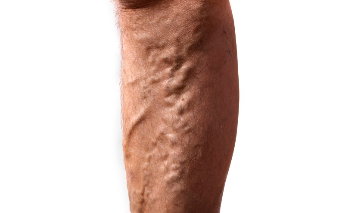Bulging veins are a symptom that can be caused by several medical conditions. Mild cases may only be a cosmetic problem. Other times, bulging veins can be a sign of a more serious problem. Seek immediate medical care if you experience sudden bulging of your veins with any of the following symptoms:
- Shortness of breath
- Chest pains
- Ulcers near the veins
These could be a sign of peripheral vascular disease or a blood clot. If you have any concerns about your bulging veins, contact your doctor for the a proper diagnosis and treatment options.
Causes of Bulging Veins
Varicose Veins - Varicose veins and spider veins are a common cause of bulging veins. Varicose veins are often dark purple or blue in color and appear bulging or distorted. Most often, they form on the legs and feet but can occur anywhere on the body. Varicose veins may also become painful after you have been standing or sitting for a long time. Spider veins are a milder version of varicose veins. Like varicose veins, they can occur anywhere but are more commonly seen on the face.
Venous Insufficiency - Inside each vein is a series of valves that prevent the blood from flowing backward. If the valves are not working right—and the walls of the veins have weakened—the blood can pool inside the vein. This condition is called venous insufficiency. This usually affects deeper veins inside the leg but can also cause veins near the surface to bulge (varicose veins).
Pregnancy - One of the main risk factors for varicose veins is pregnancy. During this period, pressure on the veins increases, making it harder for the blood to flow back to the heart. Consequently, the total volume of blood in the body is greater during pregnancy. Together, these can lead to bulging varicose veins.
Older Age - Vein walls contain a type of muscle that helps propel the blood back to the heart. As you age, the walls of your veins may grow weaker and more elastic. This allows the blood to pool and lead to bulging veins.
Thrombophlebitis - When a blood clot forms inside a vein, it can sometimes cause the vein to bulge. The blood clot usually occurs in the leg, although it can also form in a vein in the arm or neck This condition can affect both deep veins and those on the surface. If a blood clot inside a deep vein dislodges from the wall, the blood flow can carry it to the lungs where it may cause a pulmonary embolism, an often fatal condition.
Treatments for Bulging Veins
There are several types of treatments for bulging veins. After identifying the underlying condition, your doctor will help you choose the best treatment.
Varicose veins that develop during pregnancy often go away on their own after three months to a year after delivery.
In other cases, varicose veins can be treated with:
- Lifestyle Changes - Living a healthier lifestyle can often reduce the severity of varicose veins. This includes eating healthy, watching your weight, exercising regularly, avoiding standing or sitting for long periods, or putting your feet up frequently.
- Compression Stockings - These stockings help the veins and muscles in the legs move the blood back to the heart. They work by applying constant pressure to the legs, and can be purchased at most medical supply stores and pharmacies.
- Sclerotherapy - During this treatment, a doctor will inject the vein with a special solution. This causes the veins to form scar tissue and close. This is not harmful to the legs because the blood flow will reroute to nearby veins that are still healthy.
- Laser Surgery - During this treatment, a surgeon closes off spider veins and other smaller varicose veins with bursts of laser light. This causes the varicose veins to slowly fade and disappear. This surgery does not require incisions (cuts) or needles.
- Vein Stripping - During this surgery, a doctor removes the varicose veins through several small incisions in the skin. Your blood flow will not be affected because the blood can flow through other nearby healthy veins.
- Ambulatory Phlebectomy - This treatment is similar to vein stripping. The surgeon makes several small punctures in the skin and removes the varicose vein through those holes. This procedure can be done in an outpatient clinic.
- Endoscopic Vein Surgery - When varicose veins are more severe—such as with leg ulcers—a surgeon may choose endoscopic surgery. This involves inserting a very tiny video camera into the leg through an incision. The surgeon then removes the varicose vein through several small cuts.


